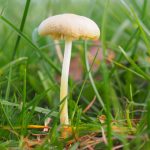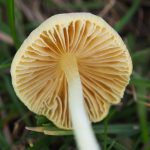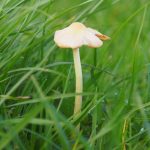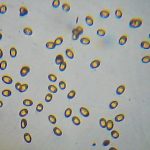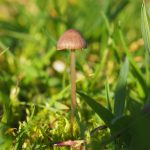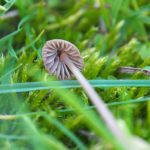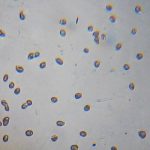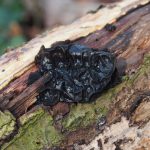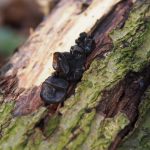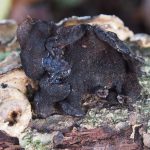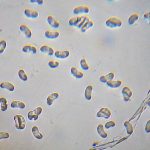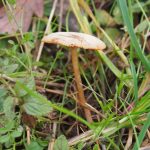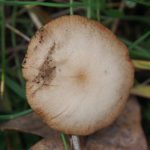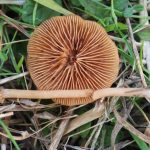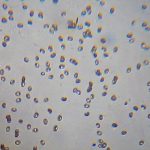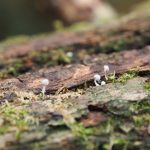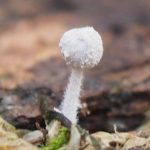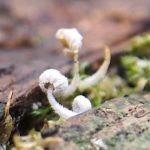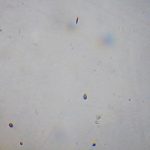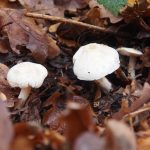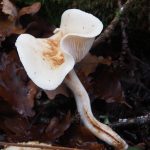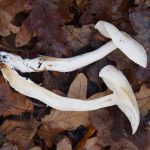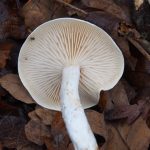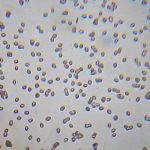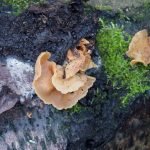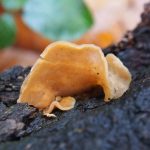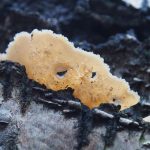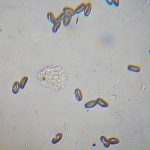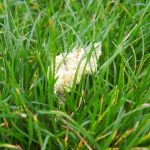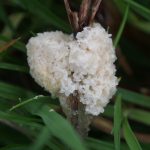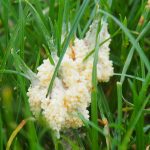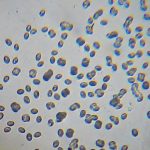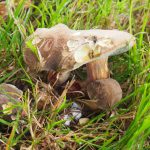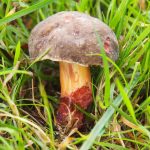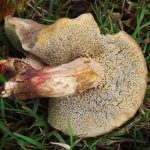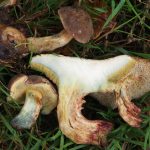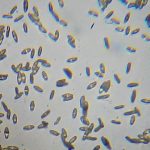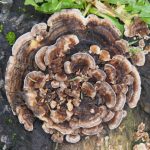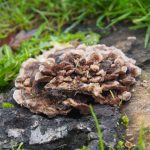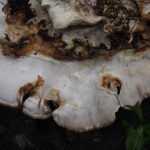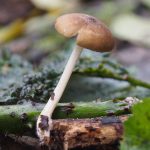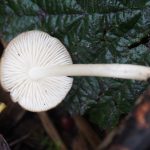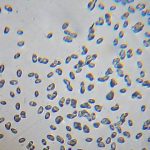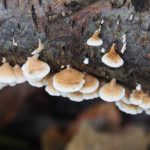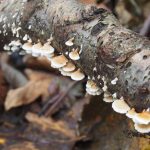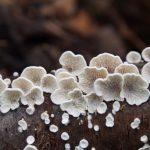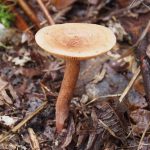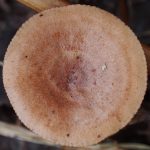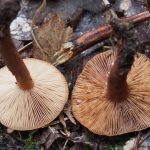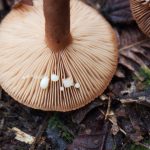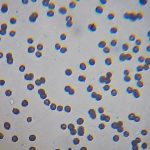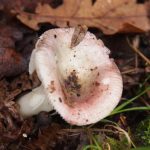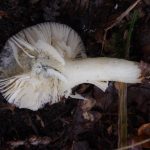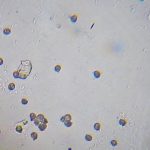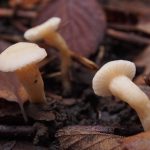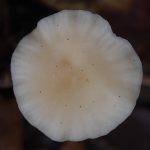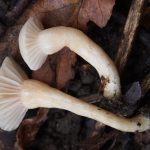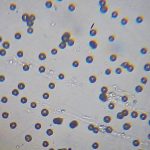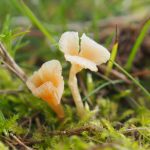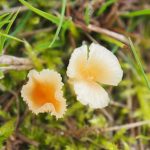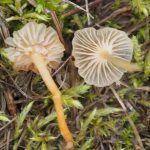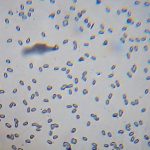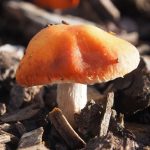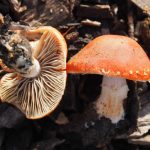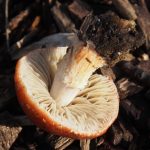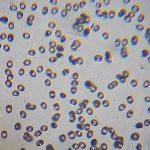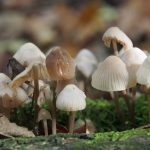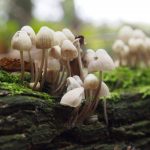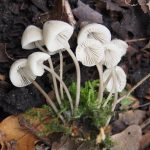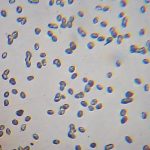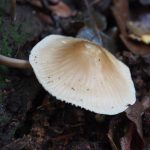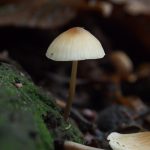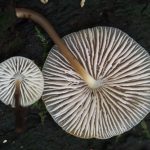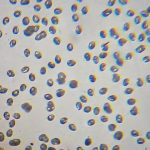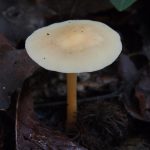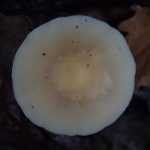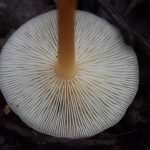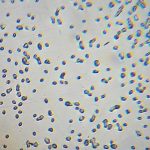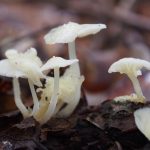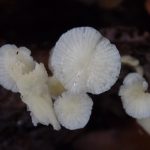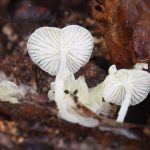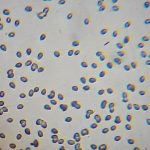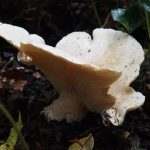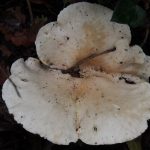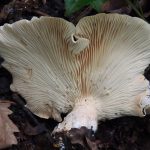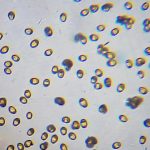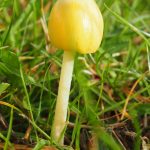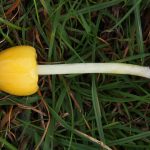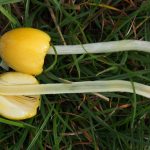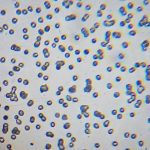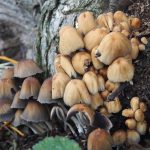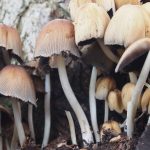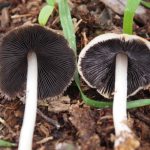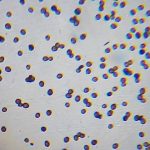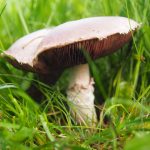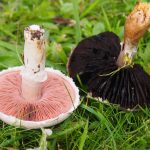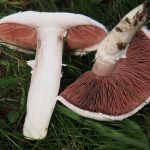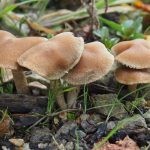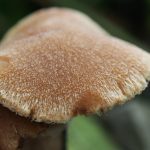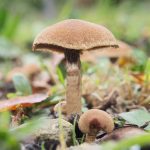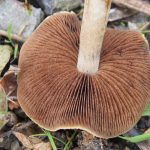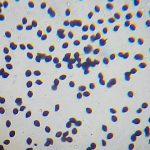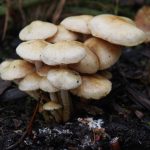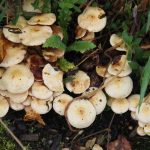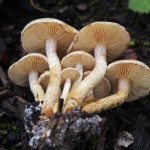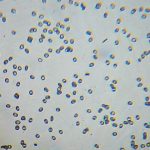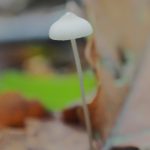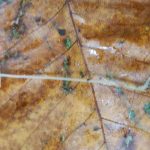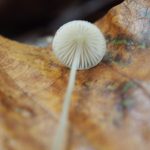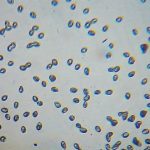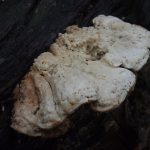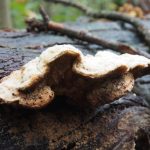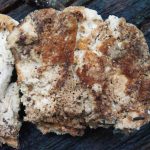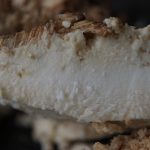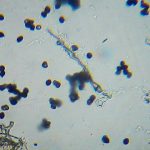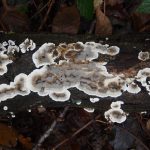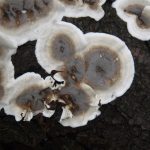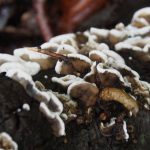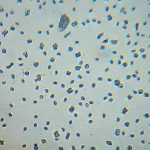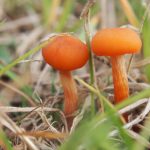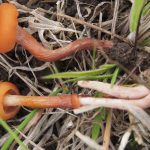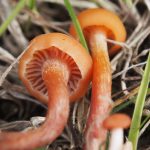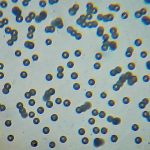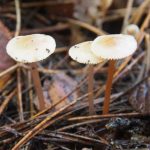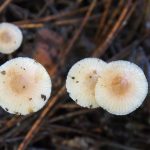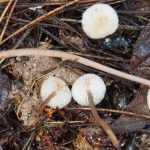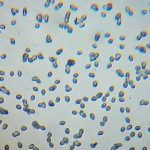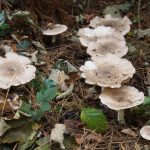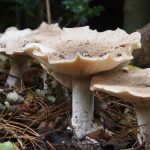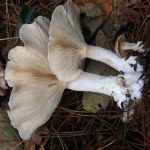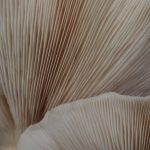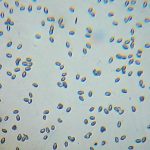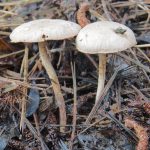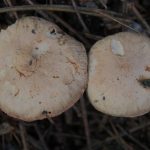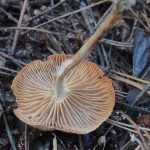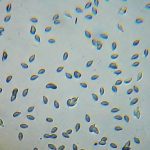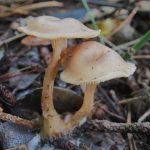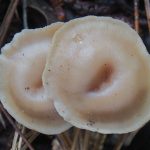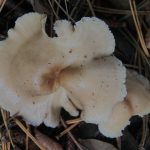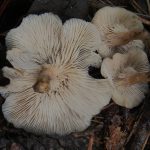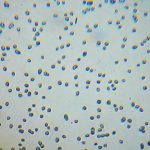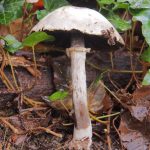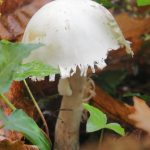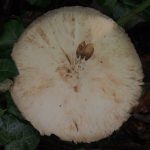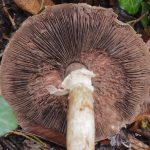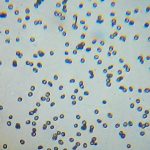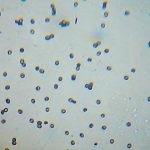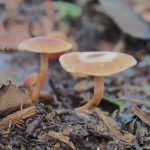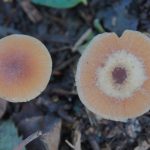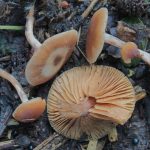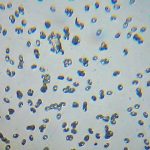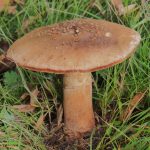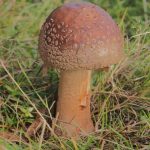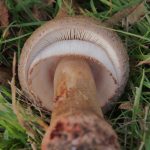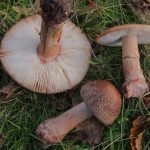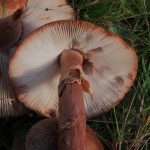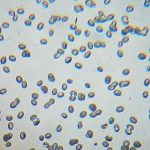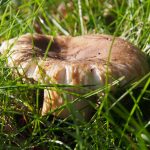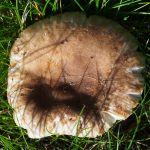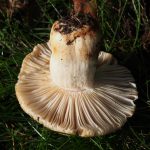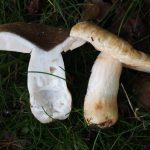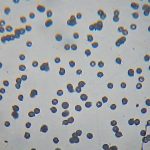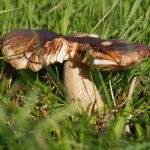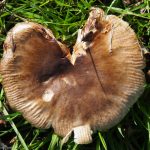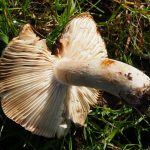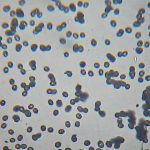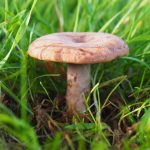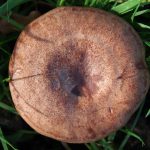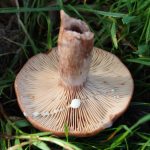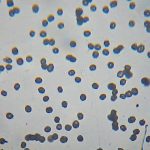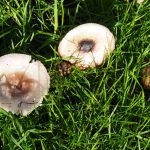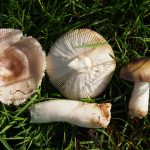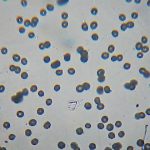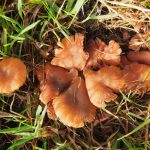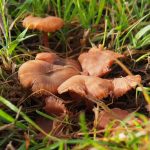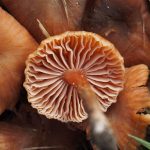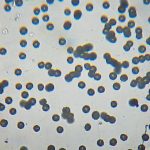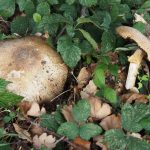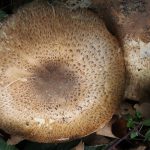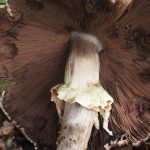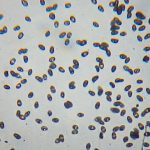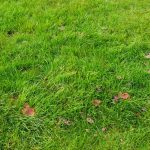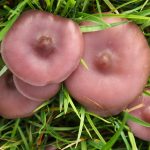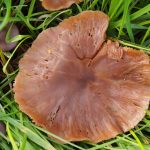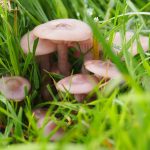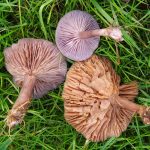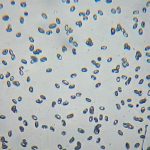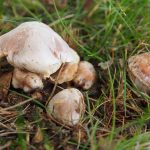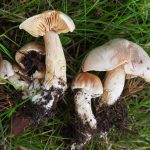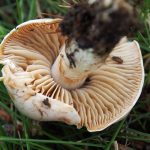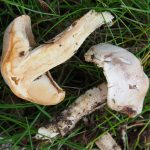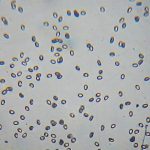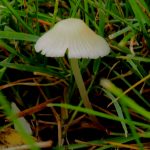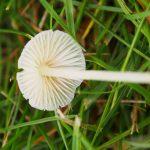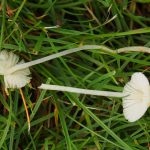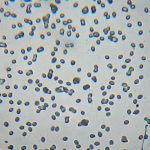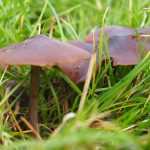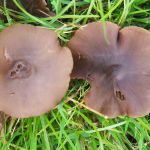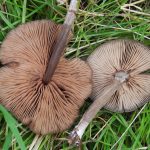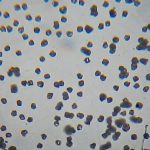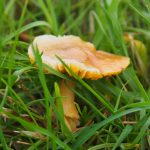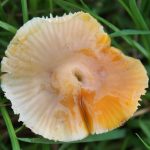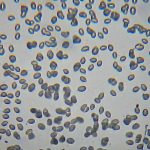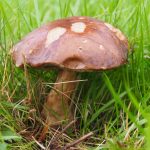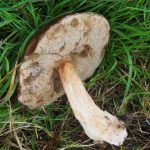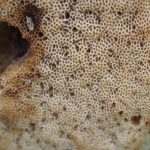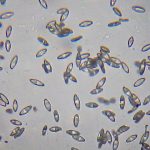Went back to Oxleas but there wasn’t a great deal to see, maybe mid-November is getting a bit too late in the season.
A few highlights: Glad to see lots of Yellow Fieldcaps in the meadow, it’s nice to find a place where a species is abundant. Witches’ Butter is a new find for me. My book says this is thought to be common but very seldom recorded. Conocybe pilosella is new for me as well, though to be honest the id is very shaky. There’s lots of similar looking Conocybes and similar genera. The unidentified tiny, tiny mushroom (no.5 below) was a very exciting find, with a cap around 1mm across! The mycena genera contains many very small species but none of my books or any online resources mention anything with a proper mushroom shape and a 1mm cap, as far as I can see. Frosty Bonnet is pretty damn small but my beauties are significantly smaller than that! Pedicel Cup is one of many similar fungus species with a cup shape and fawn or brown colour – over 100 apparently, so can’t be sure of any identification. Don’t remember ever seeing one like this on a birch log before and Pedicel Cup is commonly found on beech and elm. And lastly, Dog Vomit Slime Mould… I love finding slime mould – it’s a fascinating organism. I don’t find it very often. I expect there’s lots of it around but it just doesn’t gather into bodies very often. Also known as scrambled egg slime, or flowers of tan, and in Scandinavian folklore as troll cat vomit! Is it climbing the grass stems in order to hitch a ride or to spread its spores in the wind better?
1. Yellow Fieldcap (Bolbitius titubans).
- 1. Yellow Fieldcap
- 1. Yellow Fieldcap
- 1. Yellow Fieldcap
- 1. Yellow Fieldcap
2. Unidentified.
- 2. Unidentified
- 2. Unidentified
- 2. Unidentified
3. Witches' Butter (Exidia glandulosa).
- 3. Witches' Butter
- 3. Witches' Butter
- 3. Witches' Butter
- 3. Witches' Butter
4. Conocybe pilosella.
- 4. Conocybe pilosella
- 4. Conocybe pilosella
- 4. Conocybe pilosella
- 4. Conocybe pilosella
5. Unidentified.
- 5. Unidentified
- 5. Unidentified
- 5. Unidentified
- 5. Unidentified
6. Spotted Toughshank (Collybia maculata).
- 6. Spotted Toughshank
- 6. Spotted Toughshank
- 6. Spotted Toughshank
- 6. Spotted Toughshank
- 6. Spotted Toughshank
7. Pedicel Cup (Peziza micropus).
- 7. Pedicel Cup
- 7. Pedicel Cup
- 7. Pedicel Cup
- 7. Pedicel Cup
8. Dog Vomit Slime Mould (Fuligo septica).
- 8. Dog Vomit Slime Mould
- 8. Dog Vomit Slime Mould
- 8. Dog Vomit Slime Mould
- 8. Dog Vomit Slime Mould
6th November 2020, Beckenham Place Park
It is the fate of mushroom hunters to sometimes encounter things that they cannot identify, despite making every possible effort. Although I have many mushroom identification books, the one I use most is the Collins Fungi Guide (Buczacki) simply because it lists more species than any others, over 2400. But of course, it isn’t complete and doesn’t include many rare ones and foreign invaders. On this foray I found two specimens that I don’t recognise and can’t find in any of my books. One is a small innocuous looking single specimen growing from the end of a twig. It looks like Hydropus floccipes (which I’ve never encountered) but the spore shape is wrong. That has spherical spores whereas mine are elliptical or slightly bean shaped. I can’t find any other species with the right characteristics. The other species that I can’t identify is a small, nearly pure white one with a waxy look, growing in woodland. There’s quite a few mushrooms like that but none that I can find with spherical spiny spores. The main groups that have such spores are Brittlegill (Russula), Milkcap (Lactarius) and Deceiver (Laccaria). It’s nothing like the first two but does have the general appearance of a Deceiver, except that none of those are white.
Mycena mirata is another small Bonnet mushroom but new to me. The Suede Boletes were growing in a cluster which is very unusual for Boletes. Turkeytail is maybe the most common fungus in the country but this was an attractive rosette. Plicatura crispa is a very interesting find. This species has been confined to Scotland and the north but is apparently travelling southwards. Online I found just one record in the south, from East Susses and it’s definitely this species, as the underside with forked folds is unmistakable. Oakbug Milkcap is very common and I see it often. Pelargonium Brittlegill is a rather speculative identification as I only found one specimen and didn’t pay enough attention to details such as taste and how much the cap will peel. But it’s a nice pinkish little thing! Orange Mosscap I also see often. Redlead Roundhead is a striking orange mushroom that I haven’t seen before. It’s thought to have come from abroad and now is becoming more common in woodchip mulch environments like this.
1. Mycena mirata.
- 1. Mycena mirata
- 1. Mycena mirata
- 1. Mycena mirata
2. Suede Bolete (Boletus subtomentosus).
- 2. Suede Bolete
- 2. Suede Bolete
- 2. Suede Bolete
- 2. Suede Bolete
- 2. Suede Bolete
3. Turkeytail (Trametes versicolor).
- 3. Turkeytail
- 3. Turkeytail
- 3. Turkeytail
4. Unidentified.
- 4. Unidentified
- 4. Unidentified
- 4. Unidentified
5. Plicatura crispa.
- 5. Plicatura crispa
- 5. Plicatura crispa
- 5. Plicatura crispa
6. Oakbug Milkcap (Lactarius quietus).
- 6. Oakbug Milkcap
- 6. Oakbug Milkcap
- 6. Oakbug Milkcap
- 6. Oakbug Milkcap
- 6. Oakbug Milkcap
7. Pelargonium Brittlegill (Russula pelargonia).
- 7. Pelargonium Brittlegill
- 7. Pelargonium Brittlegill
- 7. Pelargonium Brittlegill
8. Unidentified.
- 8. Unidentified
- 8. Unidentified
- 8. Unidentified
- 8. Unidentified
9. Orange Mosscap (Rickenella fibula).
- 9. Orange Mosscap
- 9. Orange Mosscap
- 9. Orange Mosscap
- 9. Orange Mosscap
10. Redlead Roundhead (Leratiomyces ceres).
- 10. Redlead Roundhead
- 10. Redlead Roundhead
- 10. Redlead Roundhead
- 10. Redlead Roundhead
23rd October 2020, Oxleas Wood and Meadows
Oxleas Wood is an ancient woodland just 25 minutes cycle ride away from Catford, so I don’t know why I haven’t been there before! I read that parts of it date back to the last ice age, 8000 years ago, so it should be good for those fungi which prefer a primeval habitat. However, I didn’t find any particularly unusual mushrooms on this occasion although I did see a rare tree species which Oxleas is known for – the Wild Service Tree.
There weren’t many larger mushrooms but lots of smaller Bonnets (Mycena). I recorded three but could have done several others. These three were Angels Bonnet, Common Bonnet, and Frosty Bonnet. I don’t get excited about the common small brownish Bonnet species but I haven’t recorded the pure white Frosty Bonnet before and it is quite attractive. Collybia aquosa is a Toughshank without a common name. (Should it be called Pale Toughshank?) I saw several Giant Funnels growing in pasture on the Hawkwood Estate last year so I was surprised to find one growing in a wood, but apparently this does happen. I haven’t recorded Firerug Inkcap before. It sometimes has a thing called an ozonium, which is a rug like structure on the growing surface, but I didn’t see one this time.
Yellow Fieldcap is striking in its yellowness and a mushroom I’ve not seen before. It’s surprising to find it here because I’ve read that Oxleas Meadow is managed like a traditional meadow to encourage wild meadow flowers. That involves cutting the grass to make hay and normally not fertilising the grass because the wild flowers compete more easily in less fertile soil (and some mushrooms prefer that too). However Yellow Fieldcap likes a rich habitat of rotting matter, grass cuttings, dung, etc. So why is it here, unless there have been animals grazing and therefore dung? I’ll be interested to see what else I find on another occasion. A proper unimproved (i.e. unfertilized) meadow should have several Waxcap species so I’ll be looking out for those.
1. Angels Bonnet (Mycena arcangeliana).
- 1. Angels Bonnet
- 1. Angels Bonnet
- 1. Angels Bonnet
- 1. Angels Bonnet
2. Common Bonnet (Mycena galericulata).
- 2. Common Bonnet
- 2. Common Bonnet
- 2. Common Bonnet
- 2. Common Bonnet
3. Collybia aquosa.
- 3. Collybia aquosa
- 3. Collybia aquosa
- 3. Collybia aquosa
- 3. Collybia aquosa
4. Frosty Bonnet (Mycena adscendens).
- 4. Frosty Bonnet
- 4. Frosty Bonnet
- 4. Frosty Bonnet
- 4. Frosty Bonnet
5. Giant Funnel (Leucopaxillus giganteus).
- 5. Giant Funnel
- 5. Giant Funnel
- 5. Giant Funnel
- 5. Giant Funnel
6. Yellow Fieldcap (Bolbitius titubans).
- 6. Yellow Fieldcap
- 6. Yellow Fieldcap
- 6. Yellow Fieldcap
- 6. Yellow Fieldcap
7. Firerug Inkcap (Coprinellus domesticus).
- 7. Firerug Inkcap
- 7. Firerug Inkcap
- 7. Firerug Inkcap
- 7. Firerug Inkcap
14th October 2020, Farningham Wood near Swanley
I was last in Farningham Wood six years ago and it was good to return. I’ve had some great finds here in the past, including Horn of Plenty, Deathcap and Bay Bolete. On this visit, though, it seems that the fruiting of fungi hasn’t started in earnest yet. Or perhaps it’s going to be a lean year after the cornucopia of last! There were a few mushrooms to be found although wandering under the trees often resulted in nothing for twenty minutes or more.
First find was some Field Mushrooms growing on a small green on the way to the wood…, not really enough to gather for eating. The Weeping Widows were quite young and hadn’t yet started to deliquesce. Pholiota spumosa is a new species for me although the id is not certain. Coldfoot Bonnet is also new to me but these similar looking Bonnet (Mycena) mushrooms are always hard to tell apart so I’m not sure about the id. But Aurantiporus alborubescens is a great find, a rare fungus that I’ve read was first recorded in Britain in 1991 but is slowly spreading. Online there’s a confirmed record only 2 miles distant, so I’m convinced that this is right. Smoky Bracket is another new recording for me although it is very common. I might have often ignored it to focus on more exciting baubles but this was a very striking specimen. The Deceiver is also very common but very variable in appearance so hard to identify with certainty unless you look at the spores under a microscope – all the Deceivers (Laccaria) have round spiny spores.
1. Field Mushroom (Agaricus campestris).
- 1. Field Mushroom
- 1. Field Mushroom
- 1. Field Mushroom
- 1. Field Mushroom
- 1. Field Mushroom
2. Weeping Widow (Lacrymaria lacrymabunda).
- 2. Weeping Widow
- 2. Weeping Widow
- 2. Weeping Widow
- 2. Weeping Widow
- 2. Weeping Widow
3. Pholiota spumosa.
- 3. Pholiota spumosa
- 3. Pholiota spumosa
- 3. Pholiota spumosa
- 3. Pholiota spumosa
4. Coldfoot Bonnet (Mycena amicta).
- 4. Coldfoot Bonnet
- 4. Coldfoot Bonnet
- 4. Coldfoot Bonnet
- 4. Coldfoot Bonnet
5. Aurantiporus alborubescens.
- 5. Aurantiporus alborubescens
- 5. Aurantiporus alborubescens
- 5. Aurantiporus alborubescens
- 5. Aurantiporus alborubescens
- 5. Aurantiporus alborubescens
6. Smoky Bracket (Bjerkandera adusta).
- 6. Smoky Bracket
- 6. Smoky Bracket
- 6. Smoky Bracket
- 6. Smoky Bracket
7. The Deceiver (Laccaria laccata).
- 7. The Deceiver
- 7. The Deceiver
- 7. The Deceiver
- 7. The Deceiver
11th November 2019, Petts Wood and Hawkwood
November is here and the mushroom legions are beginning to falter and wither. But still quite a lot to find…
The only new species for me on this foray was Mycena metata, although the identification on it is a bit shaky. Clouded Funnel is so common that I usually ignore it but they’re so big, beautiful and numerous that sometimes I can’t resist. The theory is that these snaking lines of mushrooms follow the biggest tree roots. Wood Woollyfoot (great name!) is said to be one of the most common in Britain but not so much as Clouded Funnel in my experience. My identification of Lepista sordida is far from certain – it looks similar to one of the previous times I’ve found it but not so much the other. Yellow Stainer is apparently declining in Britain although I see it quite regularly, fairly poisonous. However, the best find today was The Blusher – dozens of these growing in a huge troop! It’s edible when cooked and the water discarded, according to the book. Not sure I’m ever going to eat one, partly because the idea of consuming any Amanita fills me with terror: some are edible and many are deadly.
1. Mycena metata.
- 1. Mycena metata
- 1. Mycena metata
- 1. Mycena metata
- 1. Mycena metata
2. Clouded Funnel (Clitocybe nebularis).
- 2. Clouded Funnel
- 2. Clouded Funnel
- 2. Clouded Funnel
- 2. Clouded Funnel
- 2. Clouded Funnel
3. Wood Woollyfoot (Collybia peronata).
- 3. Wood Woollyfoot
- 3. Wood Woollyfoot
- 3. Wood Woollyfoot
- 3. Wood Woollyfoot
4. Lepista sordida.
- 4. Lepista sordida
- 4. Lepista sordida
- 4. Lepista sordida
- 4. Lepista sordida
- 4. Lepista sordida
5. Yellow Stainer (Agaricus xanthodermus).
- 5. Yellow Stainer
- 5. Yellow Stainer
- 5. Yellow Stainer
- 5. Yellow Stainer
- 5. Yellow Stainer
- 5. Yellow Stainer
6. Unidentified.
- 6. Unidentified
- 6. Unidentified
- 6. Unidentified
- 6. Unidentified
7. The Blusher (Amanita rubescens).
- 7. The Blusher
- 7. The Blusher
- 7. The Blusher
- 7. The Blusher
- 7. The Blusher
- 7. The Blusher
28th October 2019, Beckenham Place Park
They’ve been transforming Beckenham Place Park with a new lake and café but I made sure to avoid all that! I skirted around on the grass at the edges of the wooded areas, which is often a good habitat to find interesting mushrooms. The great autumn for mushrooms is continuing…
I’ve found this park to be good for Russulas (Brittlegills) in the past and it was no different this time. The only problem is that they can be hard to differentiate and identify. It’s all very well taking pictures and notes and then sitting at home with a book afterwards, but then you find contradictions or some critical feature that you need for identification to be unrecorded. So unfortunately there were several unidentified on this occasion. The Russulas that I did identify were the Oakbug Milkcap which I know well, and the Sepia Brittlegill which I’ve not found before. Love that it smells strongly of cheese!
It was good to find The Prince again, it’s very tasty although I didn’t partake this time. Then a fabulous ring of small Wood Blewits growing in the grass and not in a wood? Seems dubious but that’s what I think I encountered. The Webcap that I found was interesting but these are hard to identify as there are so many similar species – a fascinating and often poisonous family. I love the delicate and gaudy Parrot Waxcap, which I have found before. The Brown Birch Bolete is another that I haven’t recorded before although I must have seen it, as it’s quite common and large and distinctive.
1. Unidentified.
- 1. Unidentified
- 1. Unidentified
- 1. Unidentified
- 1. Unidentified
- 1. Unidentified
2. Unidentified.
- 2. Unidentified
- 2. Unidentified
- 2. Unidentified
- 2. Unidentified
3. Oakbug Milkcap (Lactarius quietus).
- 3. Oakbug Milkcap
- 3. Oakbug Milkcap
- 3. Oakbug Milkcap
- 3. Oakbug Milkcap
4. Sepia Brittlegill (Russula sororia).
- 4. Sepia Brittlegill
- 4. Sepia Brittlegill
- 4. Sepia Brittlegill
5. Unidentified.
- 5. Unidentified
- 5. Unidentified
- 5. Unidentified
- 5. Unidentified
6. The Prince (Agaricus augustus).
- 6. The Prince
- 6. The Prince
- 6. The Prince
- 6. The Prince
7. Wood Blewit (Lepista nuda).
- 7. Wood Blewit
- 7. Wood Blewit
- 7. Wood Blewit
- 7. Wood Blewit
- 7. Wood Blewit
- 7. Wood Blewit
8. Unidentified.
- 8. Unidentified
- 8. Unidentified
- 8. Unidentified
- 8. Unidentified
- 8. Unidentified
9. Ivory Bonnet (Mycena flavoalba).
- 9. Ivory Bonnet
- 9. Ivory Bonnet
- 9. Ivory Bonnet
- 9. Ivory Bonnet
10. Lilac Pinkgill (Entoloma porphyrophaeum).
- 10. Lilac Pinkgill
- 10. Lilac Pinkgill
- 10. Lilac Pinkgill
- 10. Lilac Pinkgill
11. Parrot Waxcap (Hygrocybe psittacina).
- 11. Parrot Waxcap
- 11. Parrot Waxcap
- 11. Parrot Waxcap
- 11. Parrot Waxcap
12. Brown Birch Bolete (Leccinum scabrum).
- 12. Brown Birch Bolete
- 12. Brown Birch Bolete
- 12. Brown Birch Bolete
- 12. Brown Birch Bolete

